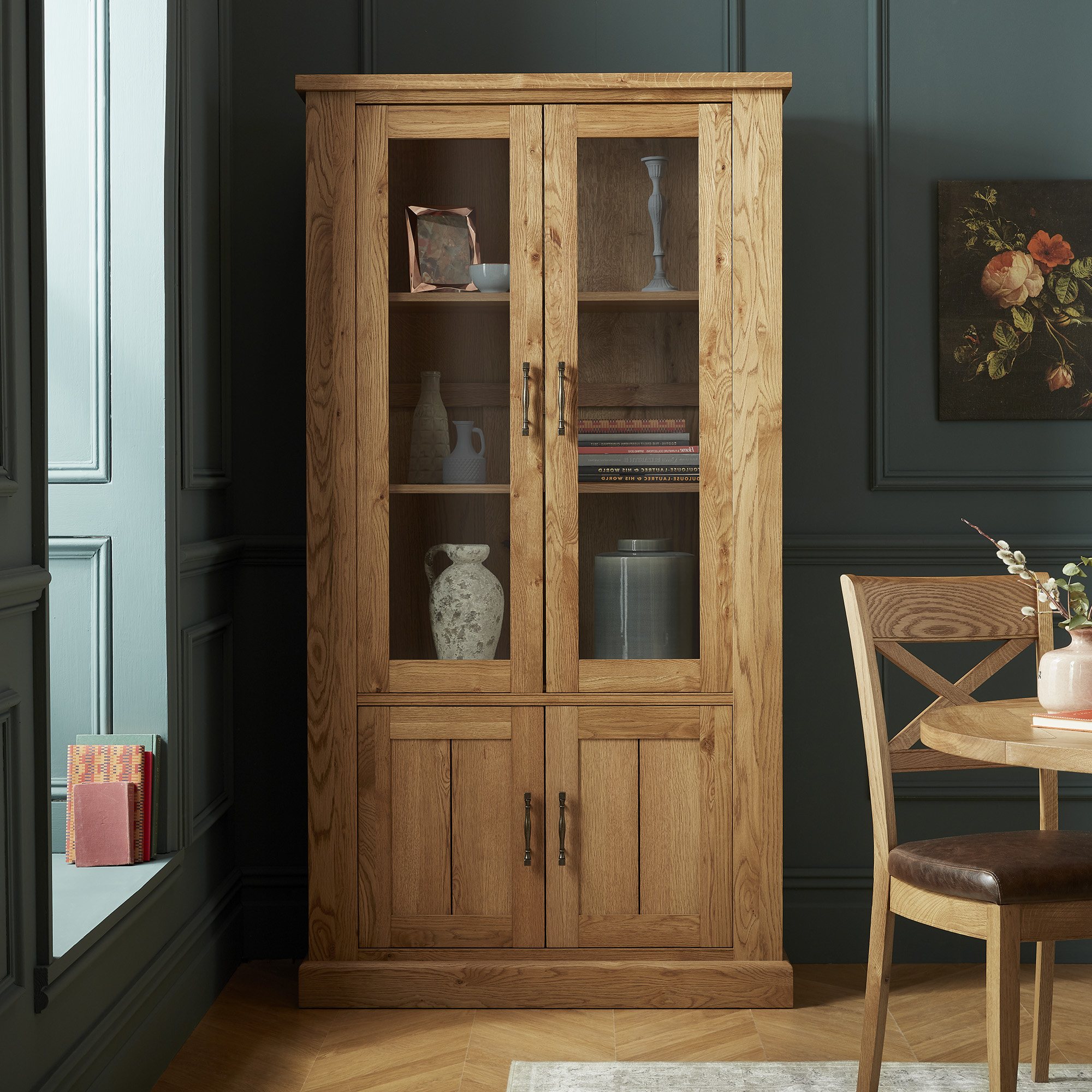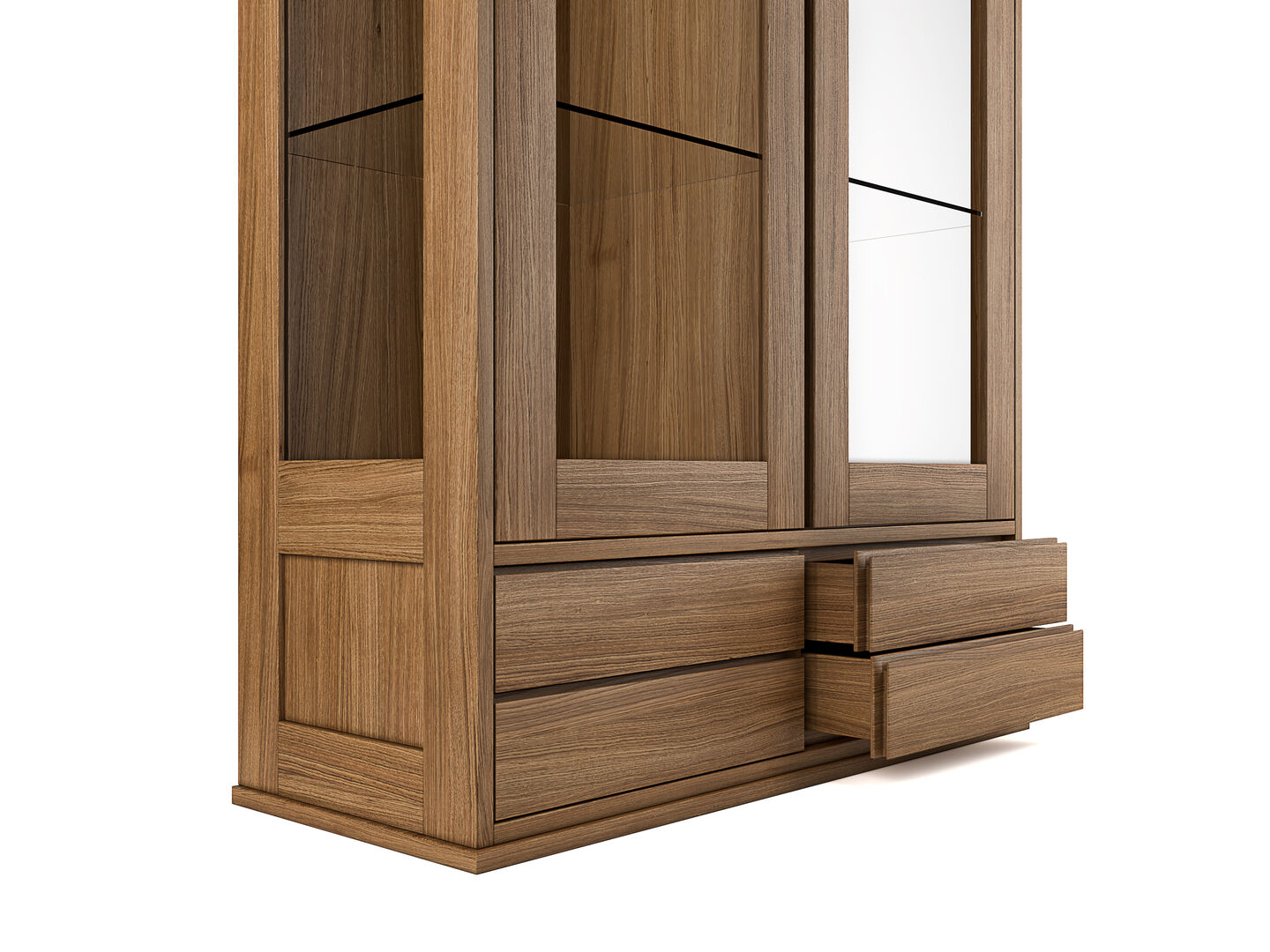Types of Solid Wood Display Cabinets

Solid wood display cabinets offer a timeless elegance and durability unmatched by other materials. The choice of wood, style, and finish significantly impacts the cabinet’s aesthetic appeal, functionality, and overall cost. This section details the various factors to consider when selecting a solid wood display cabinet.
Wood Types and Their Characteristics
The selection of wood significantly influences the cabinet’s durability, appearance, and price. Different species possess unique grain patterns, colors, and inherent strengths. The following table summarizes the characteristics of commonly used woods:
| Wood Type | Durability | Appearance | Cost |
|---|---|---|---|
| Oak | High; resistant to wear and tear | Strong grain patterns; light to dark brown tones | Medium to High |
| Mahogany | High; dense and strong | Rich reddish-brown tones; elegant and luxurious appearance | High |
| Cherry | Medium to High; relatively hard | Warm reddish-brown tones; often develops a rich patina with age | Medium to High |
| Walnut | High; strong and durable | Dark brown to almost black; striking grain patterns | High |
| Pine | Medium; softer than hardwoods | Light yellowish-brown; often features knots and variations in grain | Low to Medium |
Display Cabinet Styles
Solid wood display cabinets are available in a wide range of styles, catering to diverse aesthetic preferences.
Display cabinet solid wood – Traditional Style: Traditional cabinets often feature ornate carvings, detailed molding, and rich, dark wood finishes. They evoke a sense of classic elegance and are frequently seen in antique or period-style homes. A typical example would be a cabinet with claw feet, curved glass doors, and intricate wood inlay.
Modern Style: Modern display cabinets prioritize clean lines, minimalist designs, and often utilize lighter wood tones or high-gloss finishes. They are characterized by a lack of ornamentation and a focus on functionality and sleek aesthetics. A modern cabinet might feature simple, straight lines, glass shelving, and a metal frame.
Rustic Style: Rustic cabinets embrace a more natural and unrefined aesthetic. They often showcase the natural imperfections of the wood, such as knots and variations in color. Finishes tend to be more matte or distressed, enhancing the rustic charm. A rustic cabinet might incorporate reclaimed wood, visible wood grain, and a slightly rough texture.
Available Finishes and Their Aesthetic Impact
The finish applied to a solid wood display cabinet significantly impacts its overall appearance and longevity.
The choice of finish affects not only the visual appeal but also the cabinet’s durability and maintenance requirements.
- Stained Finishes: Enhance the wood’s natural grain and color. Various stains offer a wide range of tones, from light to dark. Stained finishes typically require a protective topcoat (e.g., lacquer or polyurethane).
- Lacquered Finishes: Provide a hard, durable surface that protects the wood from scratches and moisture. Lacquer finishes offer a smooth, glossy sheen or a more matte finish depending on the type of lacquer used.
- Polished Finishes: Offer a high-gloss, reflective surface that enhances the wood’s beauty. Polished finishes require more maintenance than other finishes, as they are more susceptible to scratches and fingerprints.
- Distressed Finishes: Create a weathered or antique look by artificially aging the wood. This can involve techniques like sanding, distressing, and applying multiple layers of paint or stain.
Features and Functionality of Solid Wood Display Cabinets: Display Cabinet Solid Wood

Solid wood display cabinets offer a blend of aesthetic appeal and practical functionality, making them suitable for a variety of applications, from showcasing prized collections to enhancing the décor of a living space. Their enduring quality and customizability contribute to their lasting value and adaptability to diverse needs. The features and functionality of these cabinets are key factors influencing their suitability for specific purposes and environments.
Common Features of Solid Wood Display Cabinets
The inherent characteristics of solid wood, combined with thoughtful design, result in several common features that enhance both the visual appeal and practical utility of these cabinets. These features contribute to the overall functionality and longevity of the piece.
- Glass Doors: Transparent glass doors allow for optimal visibility of the displayed items, protecting them from dust and minor damage while maintaining aesthetic appeal. Various types of glass, such as tempered or laminated glass, can be incorporated to enhance safety and durability.
- Adjustable Shelves: Adjustable shelving provides flexibility in configuring the interior space to accommodate items of varying sizes and shapes, maximizing storage capacity and optimizing display arrangements.
- Lighting: Integrated lighting, such as LED strip lighting or small spotlights, effectively illuminates displayed items, enhancing their visual impact and allowing for viewing even in low-light conditions. Different lighting options cater to diverse display needs and aesthetic preferences.
- Locking Mechanisms: Locking mechanisms, ranging from simple key locks to more sophisticated electronic locking systems, provide security for valuable or sensitive items, protecting them from theft or unauthorized access. The level of security offered can be tailored to individual requirements.
Dimensions, Capacity, and Suggested Uses of Solid Wood Display Cabinets
The dimensions of solid wood display cabinets significantly impact their capacity and suitability for different spaces and purposes. Careful consideration of these factors is crucial for selecting a cabinet that effectively meets individual needs. The following table illustrates the relationship between dimensions, capacity, and suggested uses.
| Dimensions (H x W x D) | Approximate Capacity (Cubic Feet) | Suggested Uses |
|---|---|---|
| 60″ x 36″ x 18″ | 30 | Large collections of china, glassware, or other collectibles; spacious living rooms or dining rooms. |
| 48″ x 30″ x 15″ | 18 | Smaller collections, trophies, or awards; smaller living spaces, offices, or hallways. |
| 36″ x 24″ x 12″ | 8 | Small collections of figurines, model cars, or other smaller items; bedrooms, entryways, or smaller spaces. |
Hypothetical Solid Wood Display Cabinet Design, Display cabinet solid wood
This hypothetical design envisions a solid wood display cabinet crafted from cherry wood, measuring 72″ in height, 48″ in width, and 18″ in depth. The cabinet features two glass doors with a beveled edge, providing a touch of elegance. Internally, three adjustable shelves made of tempered glass allow for flexible display configurations. LED strip lighting is integrated into the top shelf, illuminating the displayed items. A key lock secures the cabinet, ensuring the safety of its contents. The overall design aesthetic is characterized by clean lines, a rich cherry wood finish, and subtle brass hardware, creating a sophisticated and timeless piece suitable for a variety of interior styles. The use of cherry wood provides a warm, classic aesthetic, while the glass shelves maintain a sense of openness and showcase the displayed items effectively. The integrated lighting and locking mechanism enhance both the functionality and security of the cabinet.
Care and Maintenance of Solid Wood Display Cabinets

Protecting your investment in a solid wood display cabinet requires a proactive approach to care and maintenance. Regular cleaning and preventative measures will significantly extend its lifespan and preserve its beauty for years to come. Understanding the specific needs of your wood type—whether oak, cherry, mahogany, or another—is crucial, but the general principles Artikeld below apply broadly.
Cleaning and Maintaining Solid Wood Display Cabinets
Proper cleaning and maintenance are essential for preserving the beauty and longevity of your solid wood display cabinet. Following these steps will help you keep your cabinet looking its best.
- Dust Regularly: Use a soft, dry microfiber cloth or a feather duster to gently remove dust from all surfaces, including the interior. Pay close attention to crevices and carvings. Avoid harsh scrubbing or abrasive cloths.
- Clean Spills Immediately: Should any liquid spill on the cabinet, blot it up immediately with a clean, absorbent cloth. Avoid rubbing, as this can spread the liquid and damage the finish. For stubborn stains, use a mild soap solution and a soft cloth, rinsing thoroughly with clean water and drying immediately.
- Polish Periodically: Use a high-quality wood polish or furniture wax specifically designed for solid wood. Apply a small amount to a soft cloth and rub gently in the direction of the wood grain. Buff to a shine with a clean cloth. Avoid using excessive polish, as this can build up and create a dull film.
- Inspect Regularly: Regularly inspect your cabinet for any signs of damage, such as scratches, cracks, or loose joints. Address minor issues promptly to prevent them from becoming more serious problems.
- Protect from Direct Sunlight: Prolonged exposure to direct sunlight can cause fading and warping. Position your cabinet away from direct sunlight, especially in areas with large windows.
Preventing Common Problems
Several measures can be taken to minimize the risk of common issues affecting solid wood display cabinets.
- Scratches: Use coasters and placemats under displayed items to prevent scratches. Handle objects carefully when placing them in or removing them from the cabinet. For minor scratches, try using a touch-up pen or furniture wax that matches your cabinet’s finish.
- Water Damage: Avoid placing wet objects directly on the cabinet’s surface. Clean up spills immediately. Use coasters to protect the surface from condensation from glasses or other items. Never use excessive water or harsh chemicals when cleaning.
- Warping: Maintain consistent temperature and humidity levels in the room where the cabinet is located. Avoid placing the cabinet near heating or cooling vents. Ensure adequate air circulation around the cabinet to prevent moisture build-up.
- UV Damage: Keep your cabinet away from direct sunlight. UV rays can cause the wood to fade and lose its vibrancy over time. Consider using UV-filtering curtains or blinds on windows that receive direct sunlight.
Caring for Your Solid Wood Display Cabinet: A Personal Approach
Your solid wood display cabinet is more than just furniture; it’s a cherished piece that adds character and warmth to your home. Think of caring for it like caring for a fine antique – it deserves attention and respect. Regular dusting isn’t just about cleanliness; it’s about connecting with your cabinet, noticing the subtle grain of the wood, appreciating its craftsmanship. When you polish it, you’re not just adding shine, you’re nurturing its beauty, preserving the rich tones and patina that develop over time. A quick wipe after a spill isn’t a chore; it’s a proactive measure that prevents lasting damage. Imagine the stories your cabinet could tell – the laughter shared, the memories made, the treasures it holds. By taking care of it, you’re not only preserving its physical form, but also its history and the emotional connection it holds within your home. Let your care be a reflection of the value you place on this beautiful piece, a testament to its enduring quality and the enduring beauty of natural wood.
